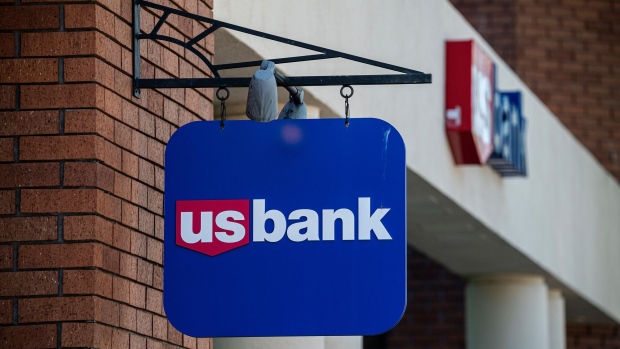Apr 17, 2024
U.S. Bancorp Trims Lending-Income Outlook Amid Deposit Pressures
, Bloomberg News

(Bloomberg) -- U.S. Bancorp reduced the outlook for a key driver of its profit for the year as lenders face pressure to pay more for deposits.
The Minneapolis-based bank said Wednesday that it now expects net interest income of $16.1 billion to $16.4 billion this year after previously guiding for NII to total $16.6 billion or more this year. The trend of customers shifting funds to interest-bearing accounts from those that don’t pay interest hasn’t slowed as quickly as expected, with rates staying elevated, executives said on a conference call with analysts.
The results and outlook for banks’ NII — the revenue they collect from loan payments minus what they pay depositors — have been a key focus for investors this quarter, as expectations for the pace of the Federal Reserve to cut interest rates have shifted dramatically throughout the three months since bank bosses last gave their regular updates.
“The reduction in guidance is disappointing given the recent reiteration of the guidance at investor conferences,” HSBC Holdings Plc analyst Saul Martinez said in a note to clients.
Shares slipped 3.6% to $39.53 at 9:39 a.m. in New York after slumping as much as 4.7% at the start of trading, their biggest intraday decline in five months. They’ve fallen 8.5% this year.
U.S. Bancorp executives expect net interest income to be roughly stable in the second quarter, and said on the conference call that NII should start growing in the second half of the year.
“Clients are just optimizing, just looking at their balance sheet, looking at their balances — especially in this higher-rate environment, and now that they know it’s going to be here for a longer period of time — they’re taking a closer eye to it,” Chief Financial Officer John Stern said on the call. “The trends have been slowing of that mix shift — it’s just taking longer than what we would have anticipated.”
In the first quarter, net interest income decreased 14% from a year earlier on a taxable-equivalent basis “due to the impact of higher interest rates on deposit mix and pricing, partially offset by higher rates on earning assets,” U.S. Bancorp said in a statement.
At an industry conference last month, Stern said the firm’s base case was for a soft economic landing and that it was working with challenged commercial-property owners on an individual basis.
The firm’s nonperforming assets rose from the prior quarter, mostly due to an increase in troubled commercial and commercial-property loans, the company said. Stephens Inc. analyst Terry McEvoy said the lower guidance for net interest income and increase in nonperforming assets may weigh on the stock in the near term.
Still, the bank gave an improved forecast for non-interest expenses, which are now expected to come in at $16.8 billion or less this year, down from previous guidance of about $17 billion.
“Despite a challenging interest-rate environment and pressure on industry deposit levels, we again saw growth in consumer deposits during the quarter,” Chief Executive Officer Andy Cecere said in the statement. Average deposits totaled $503 billion, up slightly from the previous three months.
With more than $600 billion in assets, U.S. Bancorp is one of the largest lenders in the country. Last year, it promised regulators it would shrink itself to avoid moving into a category that would subject it to even more stringent requirements.
Peer PNC Financial Services Group Inc. maintained its outlook for net interest income to decline this year when it reported results Tuesday. Regional lender Citizens Financial Group Inc. also reported results Wednesday morning, with its NII of $1.44 billion slightly above analysts’ estimates. The firm said it expects NII to be down about 2% for the second quarter.
(Updates with commentary from executives, analysts starting in second paragraph.)
©2024 Bloomberg L.P.






